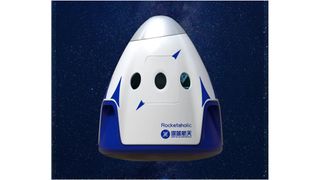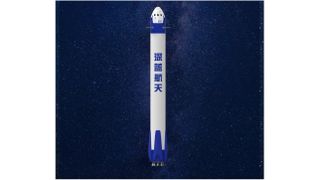
The Chinese company Deep Blue Aerospace is getting into the space tourism business.
Deep Blue, which is based in the eastern province of Jiangsu, announced on Wednesday (Oct. 23) that it plans to start launching paying customers to suborbital space in 2027.
Tickets will cost 1.5 million RMB apiece — about $210,000 U.S. at current exchange rates. For that price, customers will get "much more than a brief weightlessness experience," Deep Blue wrote in a statement on Wednesday. (Translation to English by Google.) "They will experience the vastness and mystery of the universe and witness the magnificent landscape beyond the Earth. This will be an all-round, multi-sensory space journey that will be unforgettable for a lifetime."

That statement also features renders of Deep Blue's suborbital spaceflight system — a reusable rocket-capsule combo akin to Blue Origin's New Shepard, which has conducted eight suborbital crewed flights to date, most recently on Aug. 29.
Related: New Shepard: Rocket for space tourism
New Shepard can accommodate six passengers. These folks experience a few minutes of weightlessness and get to see Earth against the blackness of space during a flight that lasts 10 to 12 minutes from liftoff to capsule touchdown. Deep Blue Aerospace's suborbital missions will likely be similar.
Blue Origin is one of two companies that has launched paying customers to suborbital space. The other is Virgin Galactic, which operates a space plane that deploys from a carrier aircraft in midair and comes back down to Earth for a runway landing. Virgin Galactic currently charges $450,000 per seat; Blue Origin has not revealed its ticket prices.
Get the Space.com Newsletter
Breaking space news, the latest updates on rocket launches, skywatching events and more!
In Wednesday's statement, Deep Blue Aerospace — which is also developing a reusable orbital rocket called Nebula-1 — said it plans to sell its first two tickets during a live event today (Oct. 24).
The purchasers will have to be patient, however; the company, which was founded in 2017, will spend several more years developing and testing its suborbital spaceflight system.
The "spacecraft-rocket combination will also undergo dozens of tests in 2026 to ensure the safety and reliability of suborbital manned travel, and officially start suborbital travel commercialization in 2027," Deep Blue representatives said in Wednesday's statement.
Deep Blue Aerospace isn't the only Chinese company with designs on the space tourism market. CAS Space, a spinoff from the Chinese Academy of Sciences, is working on a crewed suborbital vehicle of its own and could be up and running in a few years as well, if all goes according to plan.
Join our Space Forums to keep talking space on the latest missions, night sky and more! And if you have a news tip, correction or comment, let us know at: community@space.com.

Michael Wall is a Senior Space Writer with Space.com and joined the team in 2010. He primarily covers exoplanets, spaceflight and military space, but has been known to dabble in the space art beat. His book about the search for alien life, "Out There," was published on Nov. 13, 2018. Before becoming a science writer, Michael worked as a herpetologist and wildlife biologist. He has a Ph.D. in evolutionary biology from the University of Sydney, Australia, a bachelor's degree from the University of Arizona, and a graduate certificate in science writing from the University of California, Santa Cruz. To find out what his latest project is, you can follow Michael on Twitter.
-
Goryar In terms of the capsule, they look like a mix between the New Shepard and the Crew Dragon, meaning they could be sub-orbital or orbital. As for the booster, it appears to be the size of the New Shepard, but with the Falcon 9 design, its tourists may not reach the space stations, so that business model will compete with that of Blue Origin and Virgin Galactic.The one in the image is the model of the ISRO agency with an existential crisis or it seems to be also hybrid or not defined as orbital or sub orbital. I see aerodynamic louvers, but I don't see heat shields, weird.Reply -
COLGeek Reply
What does the image you posted have to do with the article and its subject?Goryar said:In terms of the capsule, they look like a mix between the New Shepard and the Crew Dragon, meaning they could be sub-orbital or orbital. As for the booster, it appears to be the size of the New Shepard, but with the Falcon 9 design, its tourists may not reach the space stations, so that business model will compete with that of Blue Origin and Virgin Galactic.The one in the image is the model of the ISRO agency with an existential crisis or it seems to be also hybrid or not defined as orbital or sub orbital. I see aerodynamic louvers, but I don't see heat shields, weird. -
Goryar Reply
Below image I so explainCOLGeek said:What does the image you posted have to do with the article and its subject? -
COLGeek Reply
I get the shielding aspect, but these are completely different systems (via a couple different countries). Your point isn't exactly clear.Goryar said:Below image I so explain
Most Popular
